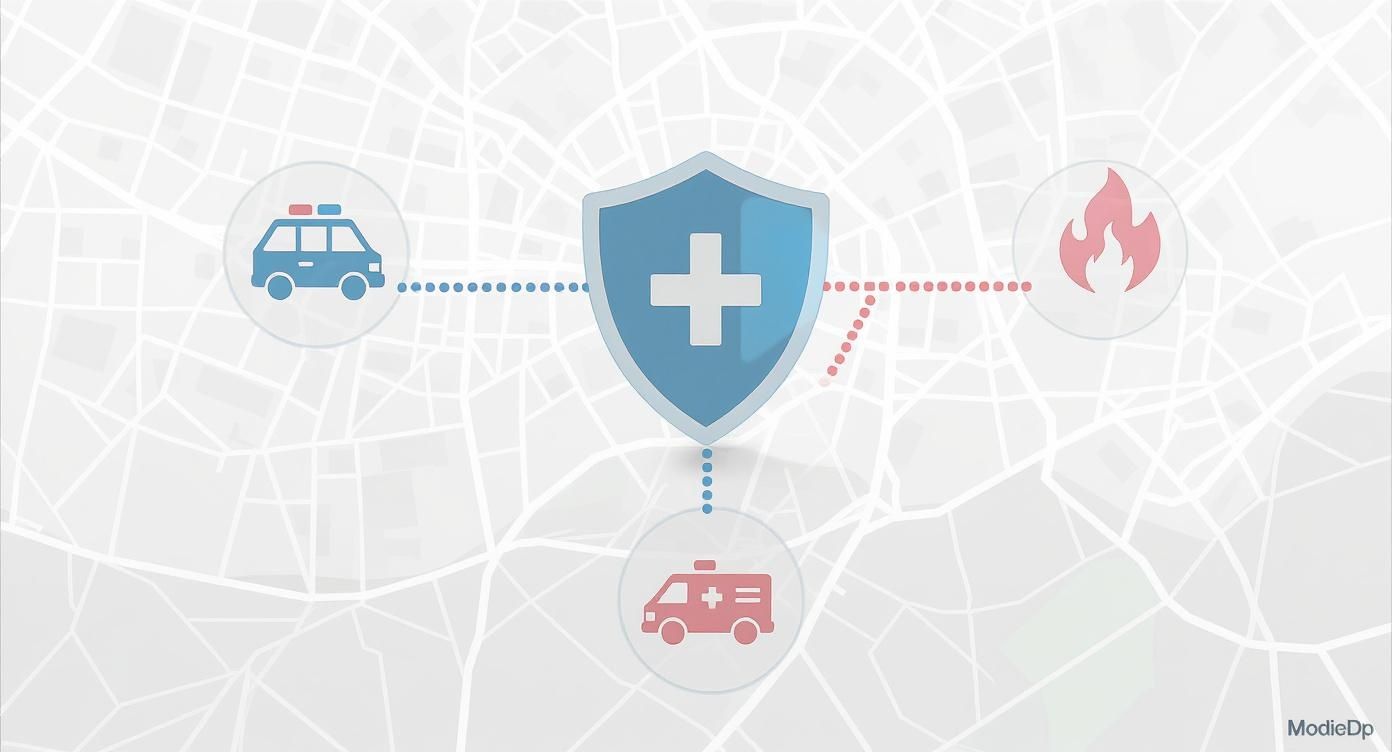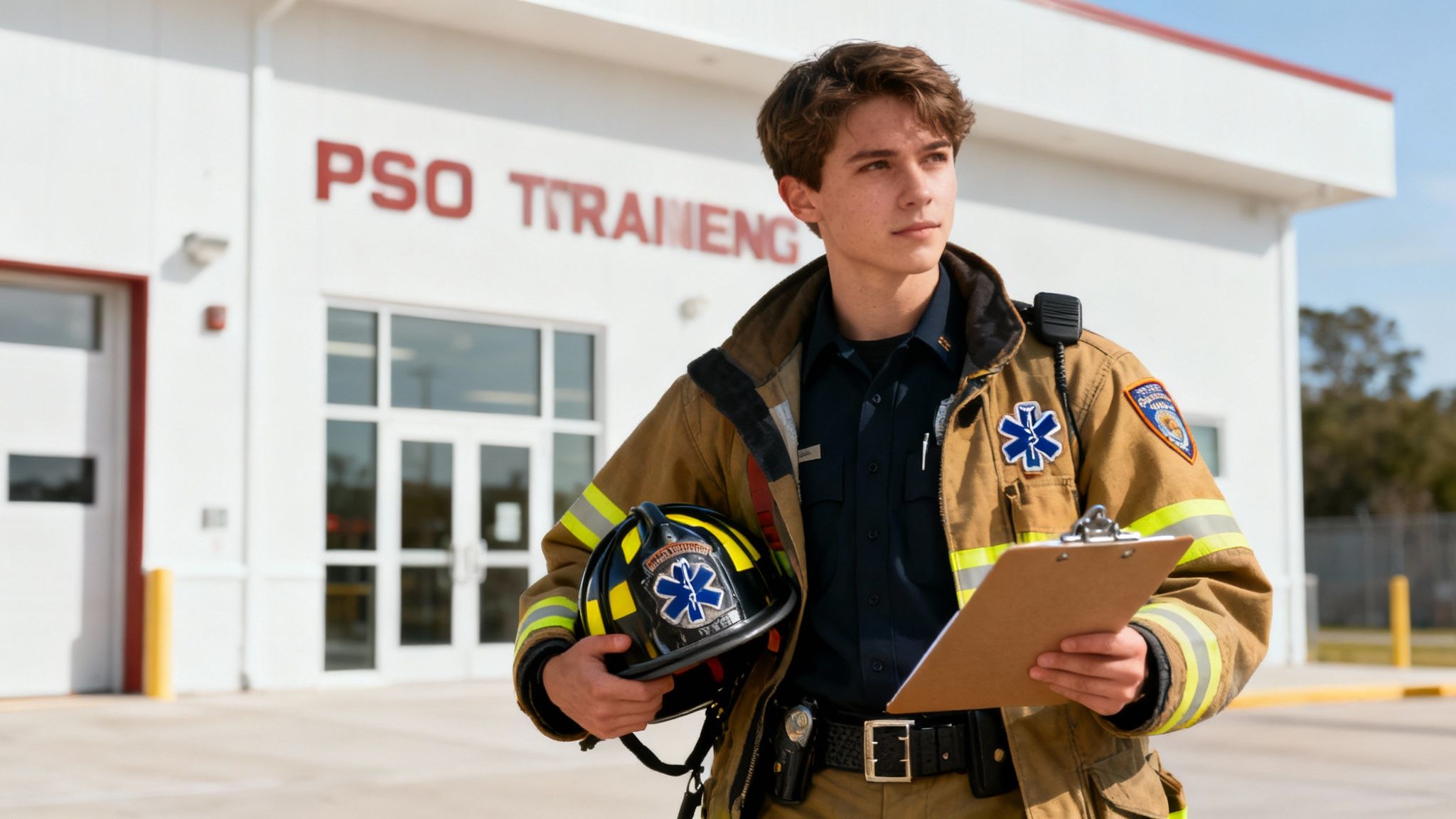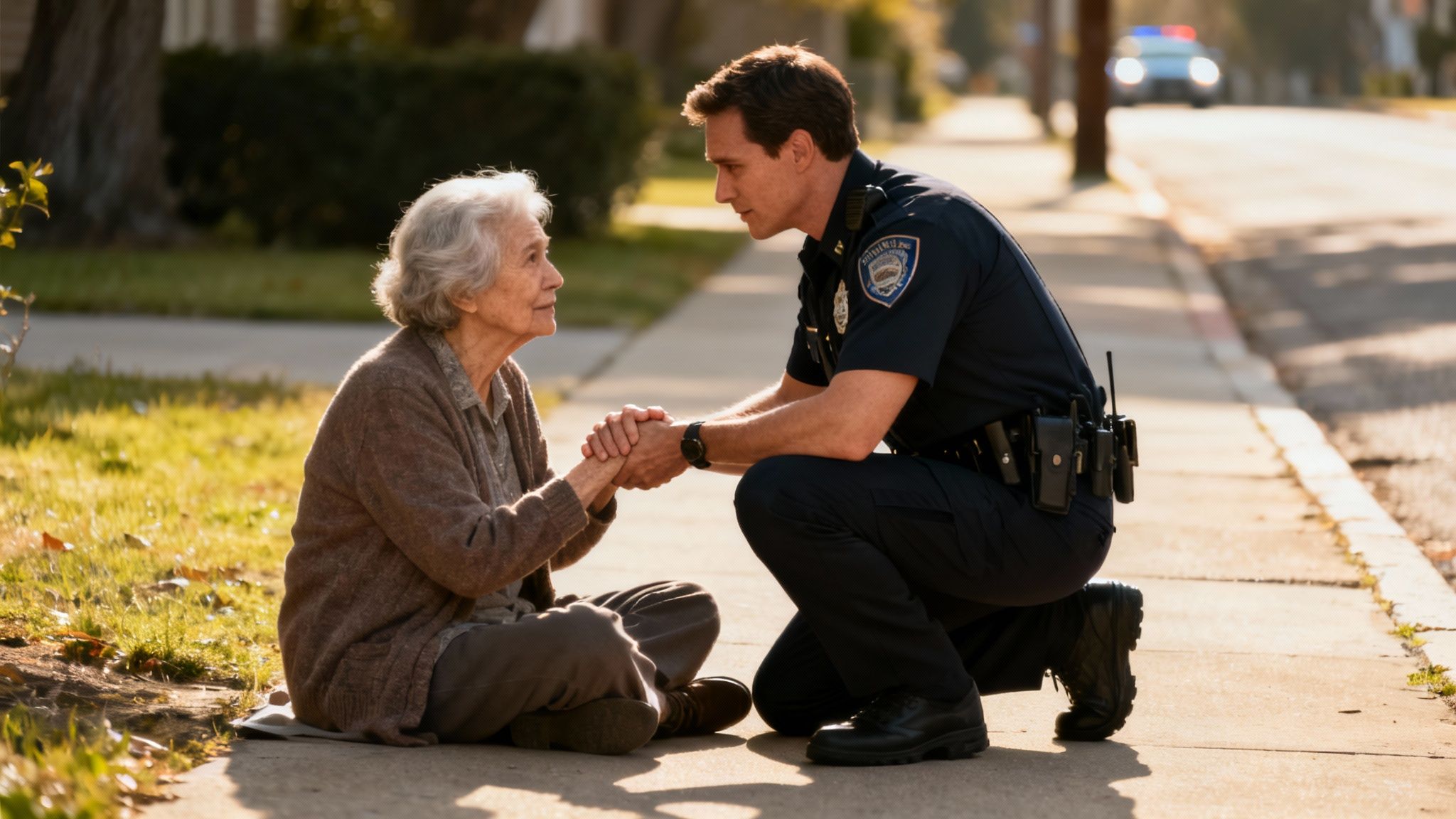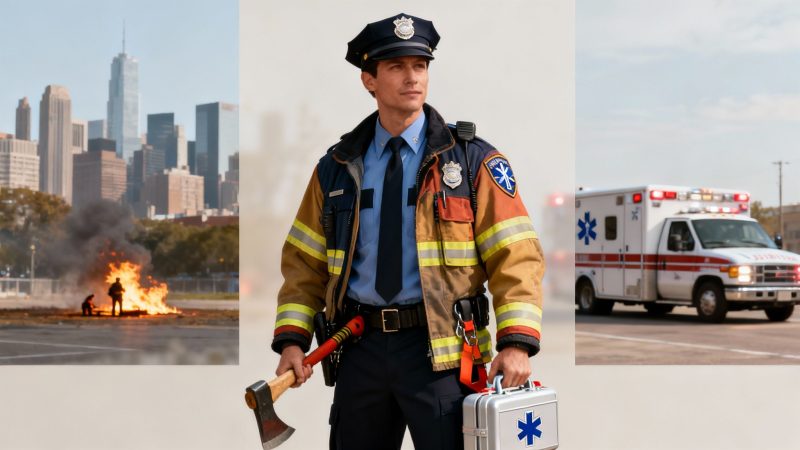What Is a Public Safety Officer? A Complete Guide
So, what exactly is a Public Safety Officer? In a nutshell, a Public Safety Officer (PSO) is a uniquely cross-trained first responder. They blend the duties of a police officer, firefighter, and emergency medical technician into a single, cohesive role.
Think of them as the 'Swiss Army knife' of community crisis response, equipped to handle a wild variety of emergencies all on their own.
Defining the Modern Public Safety Officer
Traditional emergency services often operate in silos—police handle law enforcement, fire handles fires, and EMS handles medical calls. A Public Safety Officer breaks down those walls, acting as a versatile force multiplier for any department. This integrated model is becoming a game-changer for modern communities, especially those trying to build a more efficient and cost-effective emergency response system.
Let's paint a picture with a practical example. A PSO is the first to arrive at a car accident. Instead of waiting for separate police, fire, and EMS units to show up one by one, the PSO can immediately secure the scene, triage injuries, and even put out a small vehicle fire. This multi-skilled capability can shave precious minutes off response times when every single second counts.
Core Functions and Community Impact
At their core, a PSO is a professional responsible for protecting citizens and property by maintaining order and responding to emergencies. It’s a broad role, but it’s a testament to the growing need for adaptable first responders in our towns and cities.
The numbers back this up. The global public safety and security market is on a steep climb, valued at roughly USD 575.05 billion in 2025 and projected to hit nearly USD 981.84 billion by 2030. You can dig into more of the data on this expanding market from MarketsandMarkets to see the trend for yourself.
To get a clearer idea of what a PSO does day-to-day, here’s a quick breakdown of their responsibilities.
Core Responsibilities of a Public Safety Officer
This table gives you a snapshot of the primary functions PSOs perform, really highlighting their versatile, hybrid nature.
| Responsibility Area | Key Tasks and Duties |
|---|---|
| Law Enforcement | Patrol assigned areas, enforce laws, respond to calls for service, conduct initial investigations, and make arrests. |
| Fire Suppression | Respond to fire alarms, operate firefighting equipment, perform search and rescue, and manage hazardous materials incidents. |
| Emergency Medical Services | Provide initial medical assessment and care (BLS/ALS), stabilize patients, and prepare them for transport. |
| Emergency Management | Assist with traffic control, scene security, public information, and coordinating with other agencies during large-scale incidents. |
As you can see, their duties cover the entire spectrum of emergency response, making them an incredibly valuable asset on the ground.
By consolidating three roles into one, a community can slash its operational costs. Instead of dispatching three separate vehicles and teams for a minor incident, one PSO can manage the situation. That saves fuel, personnel hours, and equipment wear-and-tear.
This approach offers a pretty clear, actionable insight for town managers. For example, instead of paying three separate overtime shifts for a late-night incident, one PSO's shift covers all bases. Investing in a PSO program can lead to serious long-term savings by optimizing how resources are used and cutting down on the need for multiple specialized responders for every single call. Ultimately, it saves taxpayer money while actually improving the level of service.
A Day in the Life: The Three Pillars of PSO Work
To really get what a Public Safety Officer is, let’s ditch the textbook definitions and look at what they actually do on the ground. The job is really built on three core pillars: law enforcement, firefighting, and Emergency Medical Services (EMS). A PSO doesn't just dabble in these areas—they have to blend them together on the fly.
Picture this practical example: A PSO pulls someone over for a routine traffic violation. Right now, they're in law enforcement mode. But as they get to the car, they see the driver is confused and slurring their words. It's not alcohol; it looks like a medical emergency, possibly a stroke.
Instantly, the officer has to switch gears. The law enforcement hat comes off, and the EMS hat goes on. They're checking vital signs and starting first aid while calling for an ambulance. They become the first line of medical care right there on the roadside.
Blending Skills Under Pressure
This ability to pivot in a heartbeat is what being a PSO is all about. A few minutes after that ambulance heads to the hospital, the same officer could get a call about a kitchen fire at a local diner.
They might get there before the fire engine does. Drawing on their firefighter training, they can grab an extinguisher and knock down the flames. That quick thinking can stop a small flare-up from turning into a full-blown structure fire, saving the business and keeping everyone safe. It’s this unique ability to shift from one critical role to another that makes them so valuable.
The infographic below really helps visualize how these three distinct jobs come together in one highly skilled professional.

This shows that a PSO isn’t just a police officer with some extra certifications. They are a true hybrid, operating right at the intersection of public safety’s most critical functions.
The Financial and Human Impact
This integrated approach is also incredibly efficient. For a smaller town, instead of sending out three separate vehicles—a police car, a fire truck, and an ambulance—one PSO in a single vehicle can often handle the initial response. This cuts down on fuel, reduces vehicle maintenance, and makes the most of every personnel hour. The savings go right back into the municipal budget.
On top of that, PSOs are constantly dealing with people in crisis. To better handle situations involving mental health emergencies, many officers get specialized Mental Health First Aid training, giving them the tools to de-escalate and provide the right support.
This multi-disciplinary skill set means faster, more effective outcomes. Having one person who can assess a scene from a law enforcement, fire, and medical perspective ensures nothing is missed and the right actions are taken immediately.
Juggling these diverse responsibilities takes an incredible amount of coordination. To see how these officers stay connected and organized in the field, you can explore the powerful communication and dispatching tools available in the Resgrid mobile apps.
The Path to Becoming a Public Safety Officer

Signing up to be a Public Safety Officer isn’t just picking a career; it's a massive commitment to mastering multiple emergency disciplines. The journey is way more demanding than what a traditional first responder goes through because a PSO has to train for three different jobs at once.
Think of it like becoming a general practitioner for public emergencies. They need a deep and practical understanding of law enforcement, firefighting, and emergency medicine to be effective the second they step out of their vehicle. It's a tough road, but it ensures they can confidently wear all three hats when the call comes in.
The Triple Certification Gauntlet
The heart of PSO training is a true gauntlet: graduating from a police academy, a fire academy, and an Emergency Medical Technician (EMT) program. Each one is a massive undertaking on its own, testing a unique set of physical and mental skills.
- Police Academy: This is where they learn the law, defensive tactics, firearm proficiency, and crucial de-escalation skills.
- Fire Academy: Training here is all about fire suppression, handling hazardous materials, search and rescue, and operating complex life-saving equipment.
- EMT Certification: This part demands a mastery of patient assessment, trauma care, and other life-saving medical interventions.
On top of all that, candidates have to pass intense physical fitness tests and detailed psychological evaluations. The agencies need to know they can handle the high-stress, high-stakes nature of the job. It's a real test of grit and dedication.
Here's an actionable, money-saving insight: If you’re even thinking about this path, a great way to get a head start is by taking introductory courses like CPR or EMT-Basic at a local community college. This can sometimes count as credit towards academy requirements, saving you both tuition money and time. Building that foundation now will make the academy training a lot more manageable.
Continuous Education and Staying Ahead
The training doesn't just stop with a graduation certificate. A Public Safety Officer has to constantly keep learning to maintain their diverse set of certifications. This ongoing commitment keeps their skills sharp and current with the latest protocols and tech.
Here's another practical tip for anyone serious about this career: start cross-disciplinary physical training as early as possible. For example, combine weightlifting (for strength needed in firefighting) with long-distance running (for endurance needed in patrol). Building a solid fitness base that combines strength, endurance, and agility will seriously lower your risk of injury during the academies. Avoiding injuries saves a ton of money, time, and potential career setbacks.
The Human Side: Challenges and Rewards of the Job

Let's be clear: being a Public Safety Officer is so much more than a 9-to-5. It's a high-stakes calling that asks a lot from the people who answer it. Officers are constantly walking into crisis situations, and that consistent exposure to trauma takes a real psychological toll over time.
This isn't something to be taken lightly. The demanding nature of the job can lead to serious stress and burnout. For anyone facing these battles, it's crucial to know that support is out there; you can explore effective treatments for PTSD and other resources designed for first responders.
Balancing the Scales
On top of the mental strain, the role is just plain physically exhausting. Emergency services across the country are dealing with persistent staffing shortages and recruitment headaches, which only piles more pressure onto the officers already on the streets.
The numbers don't lie. A 2024 survey of law enforcement personnel found that a staggering 69% reported high fatigue levels. Even more concerning, nearly 29% said they were experiencing very high fatigue, shining a spotlight on just how strenuous this work is.
But for all the immense challenges, there's a profound sense of reward that you just can't find anywhere else. At its core, this job is about making a real, tangible difference when people are at their most vulnerable.
That deep sense of purpose is the fuel. It’s what makes the long hours, the missed family events, and the intense pressure all worthwhile.
Think about this practical example: A single PSO might be the first to arrive at a house fire. In one moment, they're using their firefighting training to knock down the flames before the home is lost. In the next, they're switching gears to use their medical skills to treat a resident for smoke inhalation. That one officer, with their hybrid skillset, can be the single reason a family still has a home—and their loved one is safe.
That’s a feeling of fulfillment that's hard to put a price on.
How Technology is Changing the Game for Public Safety
Today’s Public Safety Officers have access to some incredibly powerful tools that are completely changing how they operate. This isn't just about big, well-funded departments anymore; smart, practical solutions are putting advanced capabilities into the hands of agencies of all sizes. The entire approach is shifting from just reacting to emergencies to proactively managing safety in our communities.
A huge part of this change comes down to data. It's one thing to respond to a call, but what if you could anticipate it?
As a practical example, AI-powered predictive analytics can chew through historical crime data to flag potential hotspots. This lets a department strategically place a Public Safety Officer in a specific neighborhood during peak times before an incident even occurs, acting as a visible deterrent and ensuring a much faster response if something does kick off.
The growth in this space is staggering. The global public safety analytics market was valued at USD 12.14 billion in 2025 and is on track to blow past USD 43 billion by 2032. This isn't just a trend; it's a massive shift driven by the demand for smarter decision-making in how we handle emergencies and allocate our resources.
Integrated Tools for a Smarter Response
Beyond just predicting trouble, technology is finally tearing down the communication walls that used to plague first responders. A modern PSO isn't juggling multiple radios and notepads. They’re relying on integrated platforms that put everything they need right at their fingertips.
Imagine an officer responding to a call. With the right tools, they can instantly see dispatch notes, any history associated with the location, and the real-time location of every other unit on a single screen. This kind of seamless information flow is absolutely critical for situational awareness and, ultimately, for officer safety. To see what this looks like in practice, you can explore the features of the Resgrid platform that bring dispatch, messaging, and personnel tracking all under one roof.
Actionable Money-Saving Insight: Smaller departments can drastically cut operational costs by adopting cloud-native platforms for dispatch and records management. This approach eliminates the need for expensive on-premise servers and dedicated IT staff, saving thousands annually while providing immediate access to the latest security and feature updates.
By being smart about the tech they adopt, agencies can do a lot more with less. Moving away from clunky, expensive physical infrastructure frees up budget that can be put back into what really matters: personnel and community-focused programs that improve public safety for everyone.
A Few Common Questions About PSOs
It's a newer model for emergency services, so naturally, people have questions about what a public safety officer actually is and how the whole thing works. Let's tackle some of the things we hear most often.
One of the biggest questions is whether a PSO is just a cop with a few extra certifications. The short answer is no; it’s a completely different way of thinking. A true PSO is trained from the ground up to switch hats between law enforcement, fire suppression, and EMS, often being the first and only person on the scene for the initial response.
Is a Public Safety Department the Right Move for Every Town?
While the PSO model can be a game-changer, it's definitely not a one-size-fits-all solution. We've seen it work best in small to mid-sized communities where the call volume allows a single, highly-trained officer to manage different types of incidents effectively.
For example, a rural town with 5,000 residents might find a PSO model highly cost-effective, as they can cover patrol, minor medical calls, and initial fire response without needing three fully-staffed, separate departments. Once you get into bigger, denser cities, the sheer number and complexity of calls usually mean you need more specialized units to keep up.
Here's an actionable insight: A key starting point for any town council or city manager is a straight-up cost-benefit analysis. A PSO program can save a surprising amount of money by not needing three separate sets of people and vehicles for every single call, which trims down long-term costs like fuel, maintenance, and salaries.
What's the Career Outlook Like?
The career outlook for public safety officers is really strong. As more towns and cities look for smarter, more efficient ways to handle emergency services, the demand for people who can do it all is only going to go up. Think about it—if you're certified as a police officer, firefighter, and an EMT, you're an incredibly valuable and flexible asset for any department.
A common myth is that PSOs get paid less than their specialized counterparts. A lot of the time, it's actually the opposite. That extensive, cross-disciplinary training and broad skill set often means a higher salary, reflecting just how much responsibility these officers carry.
If you have technical questions or want to see the kind of modern tools that help these departments run smoothly, you can find a ton of good info over on Resgrid’s comprehensive support page. It gives you a much better feel for the technology these officers rely on every day.
Resgrid provides a unified, open-source platform designed to help public safety officers and first responders manage dispatching, communication, and personnel tracking all in one place. Discover how our system can support your team's mission at https://resgrid.com.

